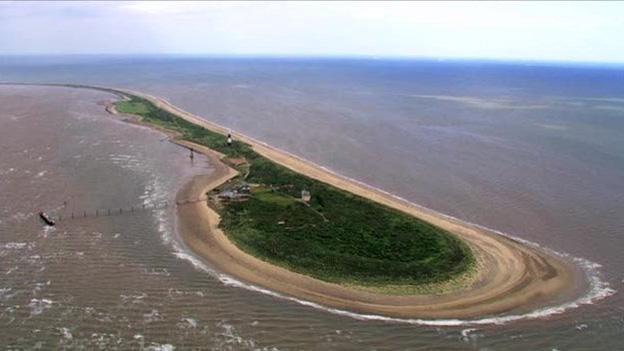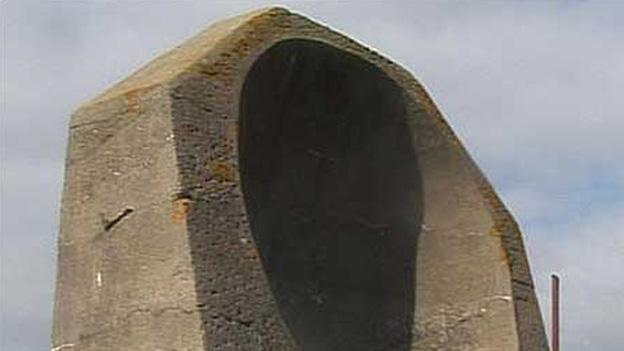World War One: Spurn Point's military relics at sea's mercy
- Published

Spurn Point has been home to military installations since the early 19th Century
Standing at the mouth of the Humber Estuary, the narrow peninsula of Spurn Point has long been a strategically important part of the UK's defences - but none more so than during World War One.
It juts 3.5 miles (6km) into the North Sea and guards entry to the ports of Hull, Grimsby and Goole.
Defence installations on the point date back to the Napoleonic Wars, with a gun battery and associated barracks established there in about 1805.
But, when World War One was declared on 4 August 1914, military activity expanded and came to dominate the area like it had never done before.
Within 12 hours, the village of Kilnsea at the top of the peninsula found itself home to a garrison of more than 500 troops.
As the war continued further defences were built along Spurn Point.
Those trenches, gun emplacements and other bases were then linked by a narrow gauge railway line.
Sound mirror
One Kilnsea resident Ernie Norwood, an eight-year-old schoolboy in 1914, recalled the militarisation of the area in his memoirs, published in 1997.
He remembered the fear villagers felt as German Zeppelin airships flew overhead on their way to bomb Hull.
"Sometimes they were only about 50 feet high when they passed over Kilnsea," he said.
"The real worry was when they jettisoned their bombs on the way out."
One legacy of the raids is the sound mirror, which still stands in a field just outside the village.

Spurn Point had a number of military bases built during World War One
The large concave concrete dish acted as a primitive radar, amplifying engine sounds from distant Zeppelins so they could be heard by an operator, who would then send an air-raid warning inland by radio.
Now a nature reserve, the fragile spit of land, is only 50m (164ft) wide at some points.
Waves push the land ever southwards and many of the military installations have fallen into the sea.
'Terrible earthquake'
Historian and author Jan Crowther recalled being on a caravan holiday more than 20 years ago when the Godwin Battery, which held 9.2ins guns during WW1, was washed away.
"Sitting in the caravan, there was this terrible 'earthquake' and it was one of the gun emplacements falling on the beach," she said.
"They are still virtually intact. They are really quite interesting to look at."
However, the debris of war on the beach poses problems for the peninsula's ecosystem, according to Andrew Gibson, the reserve's manager for Yorkshire Wildlife Trust.
He said the trust faced the dilemma of striking a balance between trying to preserve the military history and letting nature run its course.
"The legacy of what was holding a line defending Britain is now fixing something that probably shouldn't be fixed," Mr Gibson said.
"The very nature of what Spurn is means that it needs to be allowed to move.

A WW1 acoustic mirror used to detect Zeppelins still stands in a field near Kilnsea
"You've got these old bits of concrete dotted around on the shore.
"And that affects how the waves break, how the sand moves, how the beach builds up, how it forms, which in turn affects how the peninsula performs to the south of us.
"The hardest thing to overcome is people's perception that allowing it to move is allowing it to wash away.
"Some people see the concrete as a fallen sea defence, [but it] was for military purposes, and now could well be a barrier to that movement and that change."
- Published11 January 2014
- Published3 June 2013
- Published22 June 2012